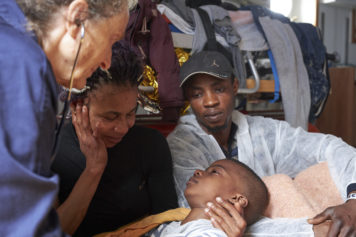In a scenario remarkably similar to recent events in the United States, the European Union is grappling with a growing crisis in which thousands of Africans and Middle Easterners are crossing the Mediterranean Sea to seek asylum, resulting in hundreds of drownings at sea and coastal towns in Greece, Italy and Spain being overwhelmed by refugees.
As possibly hundreds of thousands of people prepare to make the journey in unseaworthy vessels during what is called “boat season” over the next few months, the United Nations is even considering opening holding centers in North Africa and the Middle East to process migrants outside of Europe and discourage them from making the perilous journey on dinghies and inflatables that aren’t made for such trips.
The UN’s refugee agency, UNHCR, said the failure to execute such planning could result in a “colossal humanitarian catastrophe.”
But human rights activists aren’t convinced of the wisdom of the holding centers.
“There’s no way that could work,” Judith Sutherland of Human Rights Watch (HRW) told The Guardian. “In theory, HRW doesn’t have a problem with creating channels of access to asylum in the EU from outside, [but] you can’t imagine [the right] conditions being met in Libya today, or indeed Egypt or Morocco.”
Greece, the country that currently holds the EU presidency and which bears a brunt of the influx because of geography, is in favor of the holding centers, in addition to the establishment of an international seaborne task force to patrol the Mediterranean in an attempt to stem the flow of migrants.
Greece reportedly will introduce the ideas at an EU summit next month.
According to Frontex, the EU border agency, there’s been a dramatic increase this year in sea crossing, particularly between North Africa and Italy.
For the period January to April this year, 42,000 migrants were detected on the route from North Africa to Italy—25,650 crossing from Libya. The agency said from the eight routes commonly used there were already 60,000 migrants reaching Europe for the year, compared to 100,000 in all of 2013.
“If the current trends continue, and with the summer months approaching, there is a strong likelihood the numbers will increase further,” Gil Arias Fernandez, Frontex’s Deputy Executive Director, told BBC News.
Many of the migrants are Syrians fleeing their nation’s long-running civil war and many from countries such as Afghanistan and Eritrea that are dealing with insurgencies and brutal poverty.
Migration experts expected this flood because there had been a drop in migration during 2012, and at the beginning of 2013.
“The main route through Libya was closed for so long that people in sub-Saharan countries have been waiting for a couple of years,” Franck Duvell, associate professor at the Centre on Migration, Policy, and Society at Oxford University, told The Guardian. “So the numbers have been building up and people were waiting for the very first opportunity to move. I’m not sure this implies that we are going to see ever-more people arriving in the EU over the next couple of months. We’ve got to wait and see.”
Matters are not helped by the rise in racist xenophobia in many European nations, often driven by right-wing politicians. Just this week French riot police moved hundreds of migrants from Asia, the Middle East and Africa who were set up in a camp near the northern port of Calais.
In Spain, there was a dramatic scene in which more than 1,000 migrants stormed a razor-wire fence at Melilla, a Spanish enclave in Morocco, to reach European territory. About 400 of them made it over the barrier.
Amnesty International released a statement condemning the EU’s inaction, saying, “With virtually no safe and legal routes into Europe, people are increasingly pushed into the hands of smugglers and traffickers, and are forced to risk their lives on unseaworthy vessels.”
Enzo Bianco, the liberal mayor of Catania and former Italian interior minister, encouraged the EU to take action for the sake of the migrants.
“If strong action isn’t taken, it will be a disaster,” he said. “Either there is a strong initiative by the Italian government and by the EU, or we will be facing a real disaster of colossal proportions. If we’re in a crisis with 50,000 arrivals, imagine what will happen if there are 500,000-600,000.”
He lashed out angrily last week at a funeral in Catania for 17 migrants who died off the coast of Libya.
“Faced with a looming, colossal humanitarian catastrophe, with almost 800,000 people on the African coast ready to cross the Mediterranean … Faced with these coffins, Europe must choose [whether to] bury our consciences of civilized men along with them,” he said.
In Sicily, where refugees are being housed in makeshift accommodation, such as schools and sports halls, with inadequate reception and processing facilities, Luigi Ammatunna, the mayor of the small town of Pozzallo on Sicily’s southeastern coast, which has received 8,500 migrants this year, said something must be done.
The arrival of large numbers of migrants, including many unaccompanied children, “creates problems for us – not because we don’t want them, but because we want to provide a reception worthy of the name,” Ammatunna told The Guardian. “Receiving these people, then treating them badly, not giving them a proper welcome, not being able to give the services that we would like to be able to give them – this we do not want.”


